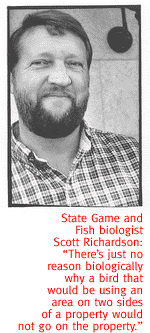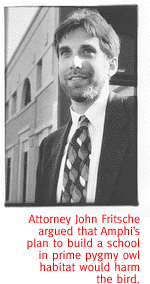
Legal Eagles Square Off Over One Troublesome Bird.
By Jim Nintzel
THE ENDANGERED cactus feruginous pygmy owl got its day
in federal court last week, when the Defenders of Wildlife faced
the Amphitheater School District.
For Amphi, the trial was the culmination of a long year which
found the district struggling to build a school on a parcel of
land which wildlife experts identify as prime pygmy owl habitat.
 Representing the plaintiffs were John Fritsche and Eric Glitzenstein,
two Washington, D.C., attorneys. Fritsche is the in-house counsel
for the Defenders of Wildlife, while Glitzenstein is a seasoned
hand at endangered species legislation who successfully stalled
the University of Arizona's plan to build telescopes on Mount
Graham over issues related to the endangered red squirrel. Unable
to win in court, the UA ultimately had Congress pass a law to
allow construction of the scopes.
Representing the plaintiffs were John Fritsche and Eric Glitzenstein,
two Washington, D.C., attorneys. Fritsche is the in-house counsel
for the Defenders of Wildlife, while Glitzenstein is a seasoned
hand at endangered species legislation who successfully stalled
the University of Arizona's plan to build telescopes on Mount
Graham over issues related to the endangered red squirrel. Unable
to win in court, the UA ultimately had Congress pass a law to
allow construction of the scopes.
Put simply, Fritsche and Glitzenstein's case was, "If you
hear a hoot, the site is kaput." They called as witnesses
a team of state, federal and private wildlife biologists who testified
that they believed, based on their experience and the available
evidence, that a pygmy owl was using a portion of Amphi's property.
Amphi's defense, meanwhile, might be summarized as, "If
it doesn't nest, you can't contest." Attorney Denise Bainton
of the DeConcini-McDonald law firm persuasively argued that the
burden was on the Defenders of Wildlife to prove that an owl would
be harmed, and because surveys have failed to detect on owl on
the Amphi property, there's no evidence that construction of the
school would do that.
"The plaintiffs will put forth evidence involving maybe's,
might be's, could be's, I don't know's," Bainton said in
her opening remarks, establishing the theme she would hammer home
in her cross-examination of the biologists.
This was a court fight Amphi would have preferred to avoid altogether.
The district had hoped the pygmy owl's proximity would prove to
be no hinderance to the school's construction, although wildlife
officials now say they had warned the district since spring of
last year that the project was in trouble.
Because the district planned to alter a wash on the property,
Amphi needed a 404 permit from the Army Corps of Engineers. But
when Amphi officials began the 404 permit process, the U.S. Fish
and Wildlife Service indicated that building a school could harm
the owl.
In late summer of last year, the district entered into formal
consultations with the Fish and Wildlife Service. Although records
of those meetings are sealed, it's clear something went awry,
because after a couple of months, Amphi officials backed out of
the consultation process and announced they would seek to purchase
additional land and reconfigure the project so that the large
wash would remain untouched and they would not longer need the
404 permit.
In March, with no formal announcement, the district began plant
salvage on the property. The next day, the Defenders of Wildlife
filed suit and got an injunction to stop construction until the
matter could be hashed out in court.
BECAUSE THE PRECISE location of the pygmy is sensitive
information, much of the trial took place with the attorneys,
witnesses and judge studying a map.
 With a low-key, methodical approach, Fritsche asked the biologists
about the pygmy owl. They described a very secretive bird, about
four inches tall--six if you include the tail--that generally
nests in sagauro cavities. It seems to feed primarily on lizards,
as well as other birds. In southern Arizona, the owl appears to
prefer a thick mix of ironwoods, palo verdes and mesquite trees,
which provide cover from predators and a home for prey.
With a low-key, methodical approach, Fritsche asked the biologists
about the pygmy owl. They described a very secretive bird, about
four inches tall--six if you include the tail--that generally
nests in sagauro cavities. It seems to feed primarily on lizards,
as well as other birds. In southern Arizona, the owl appears to
prefer a thick mix of ironwoods, palo verdes and mesquite trees,
which provide cover from predators and a home for prey.
But other questions about the owl--its range, for example--remain
mysteries.
"There's just almost nothing known about it," says
Scott Richardson, an urban wildlife specialist with the Arizona
Game and Fish Department who testified at the trial.
Richardson has been studying the pygmy owl since 1994. In 1996,
he's regularly detected at least one owl in two different locations
adjacent to the proposed school site. In 1997, his surveys weren't
as successful, although he believes he heard an owl near the site
earlier this year.
"There's just no reason biologically why a bird that would
be using an area on two sides of that property would not go on
the property," Richardson says. "It's not going to stop
at the road. The habitat is uniform across there."
Richardson has drafted the aid of several people living next
to the school district's property to record "detections"--moments
when they have seen or heard the owl. Several of the neighbors
testified in court that they had seen the owl frequently in 1996
and occasionally heard them in 1997 and in 1998. One witness,
Linda Snodgrass, said she had even seen the owl on the Amphi property.
Under cross-examination, Snodgrass admitted she didn't care much
for develoment. She described a nearby project as "armpit
houses...Houses so close to together you can lean out on window
and shake hands with the guy next door, and smell his armpit."
But for all their anti-development bias, Richardson testified
that he believed the neighbors were credible, adding he believed
construction of the school would harm the bird.
"You're talking about a species, based on what we know,
with a pretty small home range," Richardson said in an interview
after the trial. "With any species with a small home range,
you come in with a project like a high school that you plop down
in a very significant portion of its home range, you just can't
help but have an impact."
Besides the removal of the natural habitat, Richardson says building
the school will increase activity levels in the owl's range. The
commotion accompanying the construction could ultimately disturb
the owl enough to force it to abandon its territory. A bird on
the move is vulnerable to predation, and if it should move into
another pygmy owl's home range, the territorial birds could end
up fighting it out for the area.
But on the stand, Richardson--and the other biologists--had to
concede under Bainton's skillful cross-examination that they could
not be absolutely certain an owl was using Amphi's property because
they had never seen one there.
"Biology is not a science that produces concrete answers,"
Richardson says. "You're dealing with living creatures in
an ever-changing environment, and you just don't ever come up
with, 'Well, we studied it here and this is what it did and that's
how it always reacts.' You just don't do that with wildlife. There's
so many different variables. Legally, I think they're looking
for that concrete evidence that says, 'Well, this bird lives here
and here and tell me with 100 percent certainty that the bird
is on the site without having seen it.' You can't do that biologically."
THROUGHOUT THE TRIAL, Judge Zapata stayed alert and attentive,
closely studying the map and occasionally asking questions of
witnesses. In his rulings, he showed no clear bias one way or
the other. Only a hint of his opinion came when the plaintiffs
rested their case on Thursday afternoon.
When it came time for Amphi to begin its defense, Bainton moved
for a directed verdict, arguing that the plaintiff's had failed
to prove their case.
 "There has been no evidence presented that there is an owl
there," Bainton argued. "There comes a point where the
best evidence available isn't good enough."
"There has been no evidence presented that there is an owl
there," Bainton argued. "There comes a point where the
best evidence available isn't good enough."
Zapata rejected the request, although he said he was disturbed
by the fact that no one had testified that an owl was nesting
on the property and that none of the birds seemed to be using
a narrow corridor the district had agreed to leave untouched.
"I have some very serious concerns about the evidence that
has been presented," Zapata said.
While some courtroom observers thought Zapata's stinging comments
suggested he was leaning toward the school district's side, others
suggested he might have been sending a subtle message to the plaintiff's
attorneys regarding a way to strengthen their case.
When the closing arguments were completed late Friday afternoon,
Zapata praised both attorneys on a job well done and promised
he would rule quickly.
"Now the hard work falls onto me," Zapata said, "and
I will do that as quickly as I can."

|





